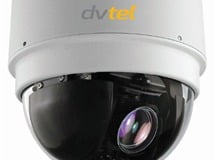I GOT my first look at DVTel Quasar at Security 2012 and was impressed by what I saw. While most people identify DVTel with software management solutions, the company has been making video surveillance cameras for many years and doing it very well. Given the company’s IP underpinnings, it’s no great surprise to find that what distinguishes DVTel Quasar most is its ability to survive in a networked ecosystem with the least possible demand on network resources.
The fundamentals of DVTel’s Quasar video surveillance cameras include 1/2.7-inch CMOS-based H.264 Day/Night HD camera with tamper and motion detection. There’s edge-based smart search metadata and 3D Digital Noise Reduction which, together with DVTel’s Scene Adaptive Algorithms, are claimed by the manufacturer to provide the industry’s highest image quality and frame rate with the lowest bandwidth and storage requirements.
Other features of Quasar cameras include up to 7 days of recording on the edge, WDR and web-based camera configuration. These cameras come with a high-resolution, fully digital front end CMOS imaging system and an automatic Day/Night IR cut filter for infrared sensitivity. They accept any C or CS standard mount lens and all of the CF series cameras can be mounted using conventional box style mounts and housings.
Both 720p and 1080p HD cameras provide H.264 video streams for up to 30 frames per second.
Quasar cameras also conform to IEEE standards and utilize the latest in multicast networking technology so that a single stream is transmitted simultaneously to multiple viewers on the network, reducing bandwidth consumption. Finally, Quasar cameras are compatible with DVTEL’s VMS solutions, a variety of ONVIF-compliant software systems, and other leading VMS platforms, for easy management on LANs and WANs.
At first glance, the fundamentals of Quasar are familiar – you get 1080p and 720p options in full body, fixed dome and PTZ variations and the compression is H.264. But while things seem familiar, Quasar has a few tricks up its sleeve. The key thing to know is that Quasar uses HD broadcast technology as opposed to typical interpretations of the H.264 compression protocol.
DVTel describes its combination of the clever compression design and adaptive algorithms as 3D noise reduction technology and according Mark Shannon, Pacific Communications’ national product manager, at the compression level Quasar achieves its light network footprint by exploiting the full suite of main profile H.264.
“What Quasar’s underlying technology is basically doing is maintaining full frame rate without using a massive amount of bandwidth, that’s the secret to Quasar,” Shannon tells me as he starts driving the camera using a nearby VMS.
“What this means is that with a 1080p camera we can continuously pan at 25ips and look – you can see on the management screen that the bit-rate is not going up (indeed, it was not going up). Competitor cameras using standard H.264 compression will either drop the frame rate or the bandwidth will go right up. So, the big deal with this Quasar camera range is its ability to maintain a high frame rate and a low bit rate in very busy scenes.”
As Shannon explains, keeping bandwidth low is a double helping of goodness for integrators, end users and IT people because it reduces the network load while at the same time reducing storage demands, critical for reducing IT PC hardware costs. At this point we try to challenge the camera, which is mounted high on the Hills stand, by finding some local backlight (a floodlight) and pointing the camera directly at it. But Quasar is unmoved by what strong light we can find in the hall.
Part of this comes down to the fact it’s a very good seeing environment in the exhibition hall, part to the challenge of getting a view above the horizontal plane and part to the performance of the camera. It simply brushes off nearby floodlights as if they weren’t there. Next we try to challenge the 25x zoom by pointing it all the way down through the front doors, across the path and into the garden out front of the exhibition hall and through to the sunlight on the other side. We are seeing the water course in the background of this shot. We can recognise clothing at a distance I guess is 60-70m. In terms of image quality, the Quasar does a fine job – the colour rendition is great.
As part of the demo, we also look at the 1080p Quasar mini dome which has IR support – it’s doing very well in the hall but there’s not the opportunity to see how it goes in low light. All in all, the Quasar range is a great new release from DVTel that is really on the money in all the areas of greatest importance – image quality and networkability.
DVTel’s Quasar Smart Camera Series is ONVIF compliant to today’s specifications and DVTel says it is committed to provide firmware updates for cameras in the field with support for the latest ONVIF release as it evolves. When ONVIF V2 is approved, DVTel will provide support for this release in every Quasar Smart Camera.
HD720 1.3MP and HD1080 2.1MP
H.264 compressions, up to 30 FPS
Advanced 3D Digital Noise Reduction
Tamper Detection
Video Motion Detection
Edge-based Smart Search Metadata
Smart IR
Advanced Camera Features
Privacy Masking
SD Slot for Edge Recording
A5 DSP Chip
Set and Forget
Wide Dynamic Range (WDR)
Smart Auto-Tune
Health Check
Bi-directional Audio
1 Alarm Input/1 Relay Output
Unicast or Multicast
12VDC/24VAC and PoE Power Options
Web Interface for configuration and control.
Click to Bookmark Post
Post Bookmarked
34.2
C
Sydney
30
C
Canberra
24
C
Darwin
14
C
Hobart
17.5
C
Perth
26.6
C
Brisbane
18.1
C
Auckland
23
C
Melbourne










